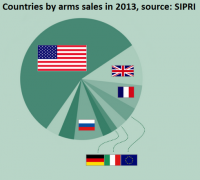-
In FBI versus Apple, government strengthened tech’s hand on privacy
The ongoing fight between Apple and the FBI over breaking into the iPhone maker’s encryption system to access a person’s data is becoming an increasingly challenging legal issue. This case is very specific, and in this narrow case, Apple and law enforcement agencies will likely find a compromise. However, this question is not going away anywhere. With the “Internet of things” touted as the next big revolution, more and more devices will capture our very personal data – including our conversations. This case could be a precedent-setting event that can reshape how our data are stored and managed in the future.
-
-
Suicide bomb detector moves close to commercialization with Sandia engineer’s help
On the chilling list of terrorist tactics, suicide bombing is at the top. Between 1981 and 2015, an estimated 5,000 such attacks occurred in more than 40 countries, killing about 50,000 people. The global rate grew from three a year in the 1980s to one a month in the 1990s to one a week from 2001 to 2003 to one a day from 2003 to 2015. R3 Technologies and a group of other small businesses are developing a way to prevent suicide attacks by detecting concealed bombs before they go off. R3 found a partner in Sandia sensor expert JR Russell who has helped bring the company’s Concealed Bomb Detector, or CBD-1000, close to commercialization over the past two years.
-
-
Refined interview technique can reveal terror plots
An interview technique for eliciting intelligence without asking questions has in a series of experiments proven to work very well. The idea dates back to the renowned Second World War interrogator Hanns Scharff, but has now, for the first time, been empirically validated. The technique can help intelligence agencies reveal plans of future terrorist acts.
-
-
Fast, lightweight autonomous air vehicle completes first flight data tests
DARPA’s Fast Lightweight Autonomy (FLA) technologies could be useful in addressing a pressing surveillance shortfall. Military teams patrolling dangerous overseas urban environments, and rescue teams responding to disasters such as earthquakes or floods, currently can use remotely piloted unmanned aerial vehicles (UAVs) to provide a bird’s-eye view of the situation, but to know what is going on inside an unstable building or a threatening indoor space often requires physical entry, which can put troops or civilian response teams in danger.
-
-
Science-based data collection key to better wildland fire defense
In February 2011, three fires raged through suburban areas outside of Amarillo, Texas, at the wildland urban interface (WUI), the area where residential communities and undeveloped wildlands meet. A new report by the National Institute of Standards and Technology (NIST) describes how researchers analyzed a major 2011 Texas wildland fire using a rigorous and scientifically based post-fire data collection approach, a system they believe will lead to improved defensive measures and strategies for significantly reducing structural damage and property loss.
-
-
More Americans support Justice Dept. than Apple in locked iPhone dispute
As the standoff between the Department of Justice and Apple Inc. continues over an iPhone used by one of the suspects in the San Bernardino terrorist attacks, 51 percent say Apple should unlock the iPhone to assist the ongoing FBI investigation. Fewer Americans (38 percent) say Apple should not unlock the phone to ensure the security of its other users’ information; 11 percent do not offer an opinion on the question.
-
-
Passwords, privacy and protection: can Apple meet FBI’s demand without creating a ‘backdoor’?
The point of encryption is to make decryption hard. However, hard does not mean impossible. The FBI could decrypt this data, with sufficient effort and computational power, and they could do this with no help from Apple. However, this route would be expensive, and would take some time. In effect, what they’re requesting of Apple is to make their job easier, cheaper and faster. Ultimately, how this matter gets resolved may depend more on the big-picture question of what privacy rights we as a society want for the data we record on our personal devices. Understanding the technical questions can inform this discussion.
-
-
Snowden ready to return to U.S. for “fair trial”
Edward Snowden has told friends and supporters he was ready to return to the United States if he could be guaranteed a fair trial. Snowden said his representatives had approached the U.S. Justice Department in an effort to negotiate a plea deal, even one involving him spending time in jail. He told the BBC Panorama last year, however, that the Justice Department had made no effort to respond.
-
-
Asia, Middle East lead rise in 2015 arms imports

The volume of international transfers of major weapons has grown continuously since 2004 and rose by 14 percent between 2006 and 2010 and 2011–2015, according to new data. Six of the top ten largest arms importers in the 5-year period 2011–15 are in Asia and Oceania. Arms imports by states in the Middle East rose by 61 percent between 2006 and 2010 and 2011 and 2015.
-
-
EUROPOL: 3,000-5,000 ISIS-trained jihadi fighters living in Europe
EUROPOL director Rob Wainwright warned ISIS is planning more attacks in Europe. Europol estimates that there are between 3,000 and 5,000 international fighters who returned to Europe from Syria. “The growing number of foreign fighters is presenting EU countries with completely new challenges,” Wainwright said.
-
-
Forensics close in on footwear analysis

First it was your fingerprint that gave the game away and then DNA analysis transformed forensic science. But “watch your step” because experts have developed a new technique which could lead to a step change in forensic footwear imaging. The experts have been able to extract additional information and create a digital picture of the personal footprint we leave behind when we stand or walk on a hard surface.
-
-
GPS allows for better, faster tsunami warnings
Existing GPS instruments at monitoring stations worldwide could be used to increase the speed and accuracy of tsunami warnings, according to a new study. Real-time Global Positioning System (GPS) measurements can be used to show how major earthquakes displace the ocean floor, cutting tsunami warning times by nearly twenty minutes and potentially reducing harm to coastal communities, according to researchers.
-
-
ISIS used mustard gas in Iraq: UN watchdog

A source at the UN chemical weapons watchdog, the Organization for the Prohibition of Chemical Weapons (OPCW), said that in 2015 ISIS attacked Kurdish forces in Iraq with mustard gas. It was the first documented use of chemical weapons in the country since Saddam Hussein used chemical weapons against Kurdish civilians in 1998.
-
-
Smartphones app creates worldwide seismic network

UC Berkeley scientists last week released a free Android app that taps a smartphone’s ability to record ground shaking from an earthquake, with the goal of creating a worldwide seismic detection network that could eventually warn users of impending jolts from nearby quakes. The app, called MyShake, is available from the Google Play Store and runs in the background with little power, so that a phone’s onboard accelerometers can record local shaking any time of the day or night.
-
-
NYPD has used Stingrays since 2008 -- with lower-level court orders rather than warrants
The NYPD has confirmed that it owns and operates Stingrays— surveillance devices that spy on cell phones nearby and which can be used to track location. In response to an NYCLU FOIL request, the NYPD disclosed it used Stingrays nearly 1,016 times between 2008 and May of 2015 without a written policy and following a practice of obtaining only lower-level court orders rather than warrants. This is the first time the extent of the use of Stingrays by the NYPD has been made public.
-
More headlines
The long view
Why Was Pacific Northwest Home to So Many Serial Killers?
Ted Bundy, Gary Ridgway, George Russell, Israel Keyes, and Robert Lee Yates were serial killers who grew up in the Pacific Northwest in the shadow of smelters which spewed plumes of lead, arsenic, and cadmium into the air. As a young man, Charles Manson spent ten years at a nearby prison, where lead has seeped into the soil. The idea of a correlation between early exposure to lead and higher crime rates is not new. Fraser doesn’t explicitly support the lead-crime hypothesis, but in a nimble, haunting narrative, she argues that the connections between an unfettered pollution and violent crime warrant scrutiny.
Bookshelf: Smartphones Shape War in Hyperconnected World
The smartphone is helping to shape the conduct and representation of contemporary war. A new book argues that as an operative device, the smartphone is now “being used as a central weapon of war.”
